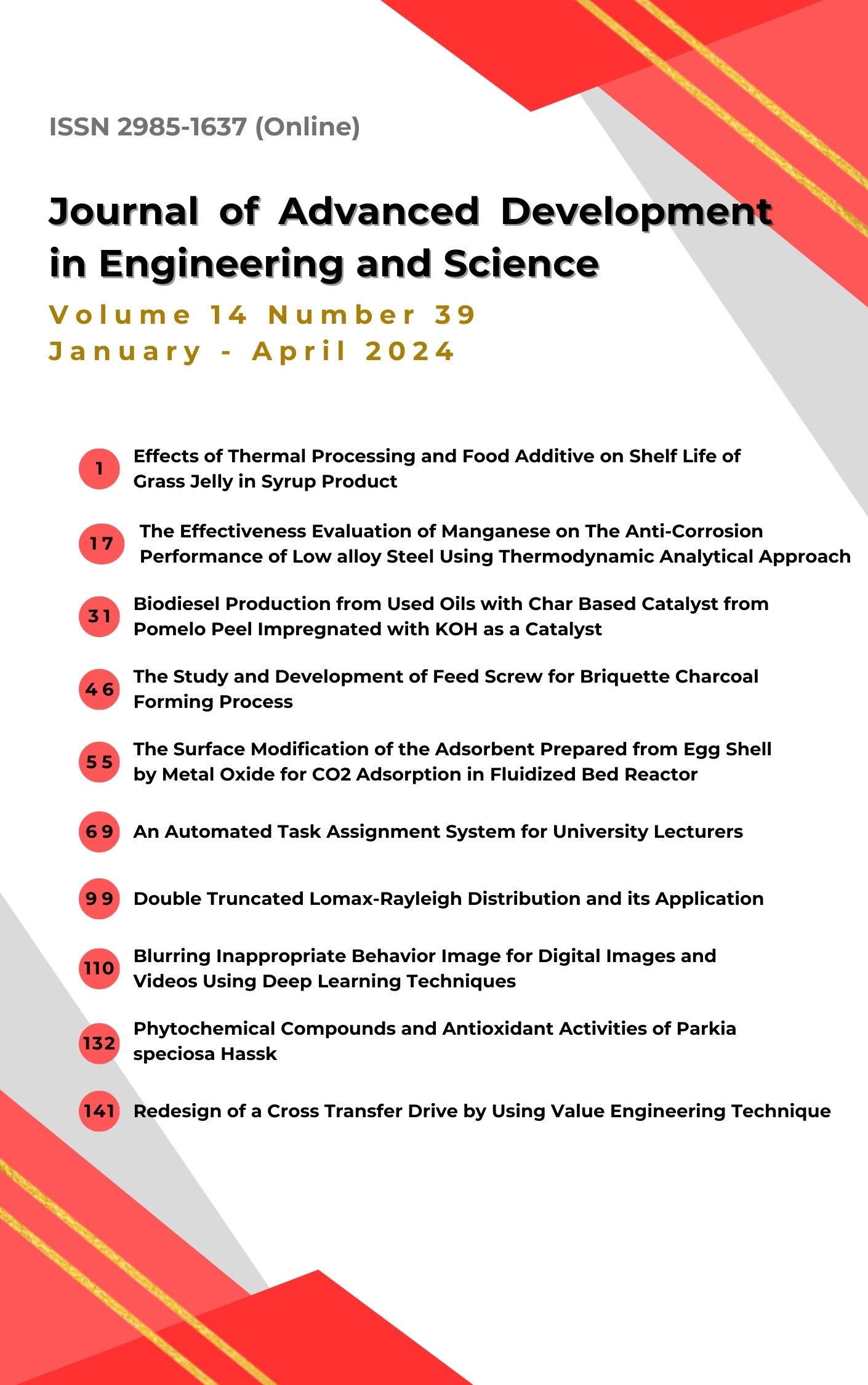พฤกษเคมีเบื้องต้นและฤทธิ์ต้านอนุมูลอิสระของเปลือกสะตอ
Main Article Content
บทคัดย่อ
การศึกษาพฤกษเคมีเบื้องต้น ฤทธิ์ทางชีวภาพและคุณสมบัติการต้านอนุมูลอิสระในสารสกัดจากเปลือกสะตอ (Parkia speciosa Hassk.) ที่สกัดด้วยวิธีการหมัก (Maceration) ด้วยตัวทำละลายอินทรีย์ 4 ชนิดได้แก่ เฮกเซน ไดคลอโรมีเทน เอทิลอะซีเตต และ เอทานอล ผลการศึกษาพบว่ามีสารประกอบพฤกษเคมีที่สำคัญ 9 ชนิด ได้แก่ อัลคาลอยด์ ฟีนอล ฟลาโวนอยด์ คูมาริน ซาโปนิน แทนนิน เทอร์พีนอยด์ สเตียรอยด์ และคาร์ดิแอกไกลโคไซด์ ปริมาณฟีนอลิกทั้งหมดของเปลือกสะตอที่สกัดด้วยเอทานอลมีค่ามากที่สุด รองลงมาคือไดคลอโรมีเทน เอทิลอะซิเตตและเฮกเซน โดยมีปริมาณสารประกอบฟีนอลิกที่สกัดได้เท่ากับ 646.83±27.72, 137.82±5.84, 7.15±0.26 และ 4.14±0.09 มิลลิกรัมสมมูลของกรดแกลลิคต่อกรัมของส่วนสกัดตามลำดับ ผลการทดสอบฤทธิ์ต้านอนุมูลอิสระโดยวิธี 2,2-diphenyl-1-picrylhydrazyl (DPPH) พบว่าสารสกัดจากเปลือกสะตอที่สกัดด้วยเอทานอลมีค่าเปอร์เซ็นต์การยับยั้ง อนุมูลอิสระสูงสุดกำจัดอนุมูลได้สูงสุด (50.6±1.51 – 63.38±0.71) รองลงมาคือสารสกัดจากเปลือกสะตอที่สกัดด้วย ไดคลอโรมีเทน เอทิลอะซิเตตและเฮกเซน ตามลำดับ นอกจากนี้ยังพบว่าเปลือกสะตอที่สกัดด้วยเอทานอลมีฤทธิ์ยับยั้งอนุมูลอิสระมากกว่าเปลือกสะตอ ที่สกัดด้วยตัวทำละลายอีกสามชนิด โดยมีค่าความเข้มข้นของสารที่สามารถยับยั้งอนุมูลอิสระ 50% (IC50) เท่ากับ 0.66±0.05, 0.14±0.002, 0.033±0.001, 0.023±0.002 และ 0.019±0.001 ไมโครกรัมต่อมิลลิลิตรที่เวลา 5, 20, 30, 40 และ 60 นาทีตามลำดับ สอดคล้องกับปริมาณฟีนอลิกโดยรวมที่มีมากที่สุดในเปลือกสะตอที่สกัดด้วยเอทานอล แสดงให้เห็นว่าเปลือกสะตอเป็นพืชที่มีศักยภาพที่สามารถ นำไปศึกษาและพัฒนาต่อยอดเพื่อทำเป็นส่วนประกอบสำคัญในผลิตภัณฑ์เวชสำอางที่ดีต่อผิวพรรณได้
Article Details

อนุญาตภายใต้เงื่อนไข Creative Commons Attribution-NonCommercial-NoDerivatives 4.0 International License.
เนื้อหาและข้อมูลในบทความที่ลงตีพิมพ์ใน Journal of Advanced Development in Engineering and Science ถือเป็นข้อคิดเห็นและความรับผิดชอบของผู้เขียนบทความโดยตรง ซึ่งกองบรรณาธิการวารสารไม่จำเป็นต้องเห็นด้วยหรือร่วมรับผิดชอบใดๆ
บทความ ข้อมูล เนื้อหา ฯลฯ ที่ได้รับการตีพิมพ์ในJournal of Advanced Development in Engineering and Science ถือเป็นลิขสิทธิ์ของ Journal of Advanced Development in Engineering and Science หากบุคคลหรือหน่วยงานใดต้องการนำทั้งหมดหรือส่วนหนึ่งส่วนใดไปเผยแพร่ต่อหรือเพื่อกระทำการใดๆ จะต้องได้รับอนุญาตเป็นลายลักษณ์อักษรจาก Journal of Advanced Development in Engineering and Scienceก่อนเท่านั้น
เอกสารอ้างอิง
Helen, C. F. H. (1986). Parkia (Leguminosae: Mimosoideae). Flora Neotropica, 43, 1-123.
Noppamas, S. (2001). Pharmacognosy “Medicine and Natural Products”. 3rd ed. Bangkok: Saengtein karnphimph. (in Thai)
Ghasemzadeh, A., et al. (2018). Assessment and Comparison of Phytochemical Constituents and Biological Activities of Bitter Bean (Parkia speciosa Hassk.) Collected from Different Locations in Malaysia. Chemistry Central journal, 12(1), 12.
Azemi, A. K., et al. (2022). Phytochemical Contents and Pharmacological Potential of Parkia speciosa Hassk. for Diabetic Vasculopathy: A Review. Antioxidants, 11(2), 431.
Chhikara, N, et al. (2018). Bioactive Compounds, Food Applications and Health Benefits of Parkia speciosa (Stinky Beans): A Review. Agriculture & Food Security, 7, 46(2018).
Adilla Zaini, N., & Mustaffa, F. (2017). Review: Parkia speciosa as Valuable, Miracle of Nature. Asian Journal of Medicine and Health, 2(3), 1–9.
Kwanjai, S. (2009). Antioxidant Properties of Stink Bean as Affected by Various Processing, (Master thesis, Prince of Songkla University). (in Thai)
Ahmad, N. I., et al. (2019). A Review on the Phytochemicals of Parkia Speciosa, Stinky Beans as Potential Phytomedicine. Journal of Food Science and Nutrition Research, 2(3), 151-173.
Wonghirundecha, S., et al. (2014). Total Phenolic Content, Antioxidant and Antimicrobial Activities of Stink Bean (Parkia specios aHassk.) Pod Extracts. Songklanakarin Journal of Science and Technology, 36(3), 301-308.
Hasim, H., et al. (2015). Antibacterial Activity of Parkia speciosa Hassk. Peel to Escherichia coli and Staphylococcus aureus Bacteria. Journal of Chemical and Pharmaceutical Research, 7(4), 239-243.
Ayoola, G.A., et al. (2008). Phytochemical Screening and Antioxidant Activities of Some Selected Medicinal Plants Used for Malaria Therapy in Southwestern Nigeria. Tropical Journal of Pharmaceutical Research, 7, 1019-1024.
Andrew, M. T., et al. (1987). Total Phenolics and High-Performance Liquid Chromatography of Phenolic Acids of Avocado. Journal of Agricultural. Food Chemistry, 35(6), 921-925.
Prommuak, C., et al. (2008). Extraction of Flavonoids and Carotenoids from Thai Silk Waste and Antioxidant Activity of Extracts. Separation and Purification Technology, 62, 444-448.
Napattaorn, B, (2019). Phytochemical Screening and Antioxidant Activity of Fresh and Dried Nosturtium officinal Plants. EAU Heritage Journal Science and Technology, 14(1), 144-154. (in Thai)
Sultana, B., et al. (2009). Effect of Extraction Solvent/Technique on the Antioxidant Activity of Selected Medicinal Plant Extracts. Molecules, 14(6), 2167–2180.
Djeridane, A., et al. (2006). Antioxidant Activity of some Algerian Medicinal Plants Extracts Containing Phenolic Compounds. Food Chemistry, 97(4), 654–660.
Gao, L., et al. (2023). Stink Bean (Parkia speciosa) Empty Pod: A Potent Natural Antidiabetic Agent for the Prevention Of Pancreatic and Hepatorenal Dysfunction in High Fat Diet/Streptozotocin-Induced Type 2 Diabetes in Rats. Archives of physiology and biochemistry, 129(1), 261–267.
Nurdyansyah, F., et al. (2023). The Effect of Stinky Bean (Parkia speciosa) Peel Ethanolic Extract to Enhance Superoxide Dismutase (SOD) and Reduce Malondialdehyde (MDA) Level of “jelantah” Exposed Rats. IOP Conference Series: Earth and Environmental Science, 1200, 012049.

